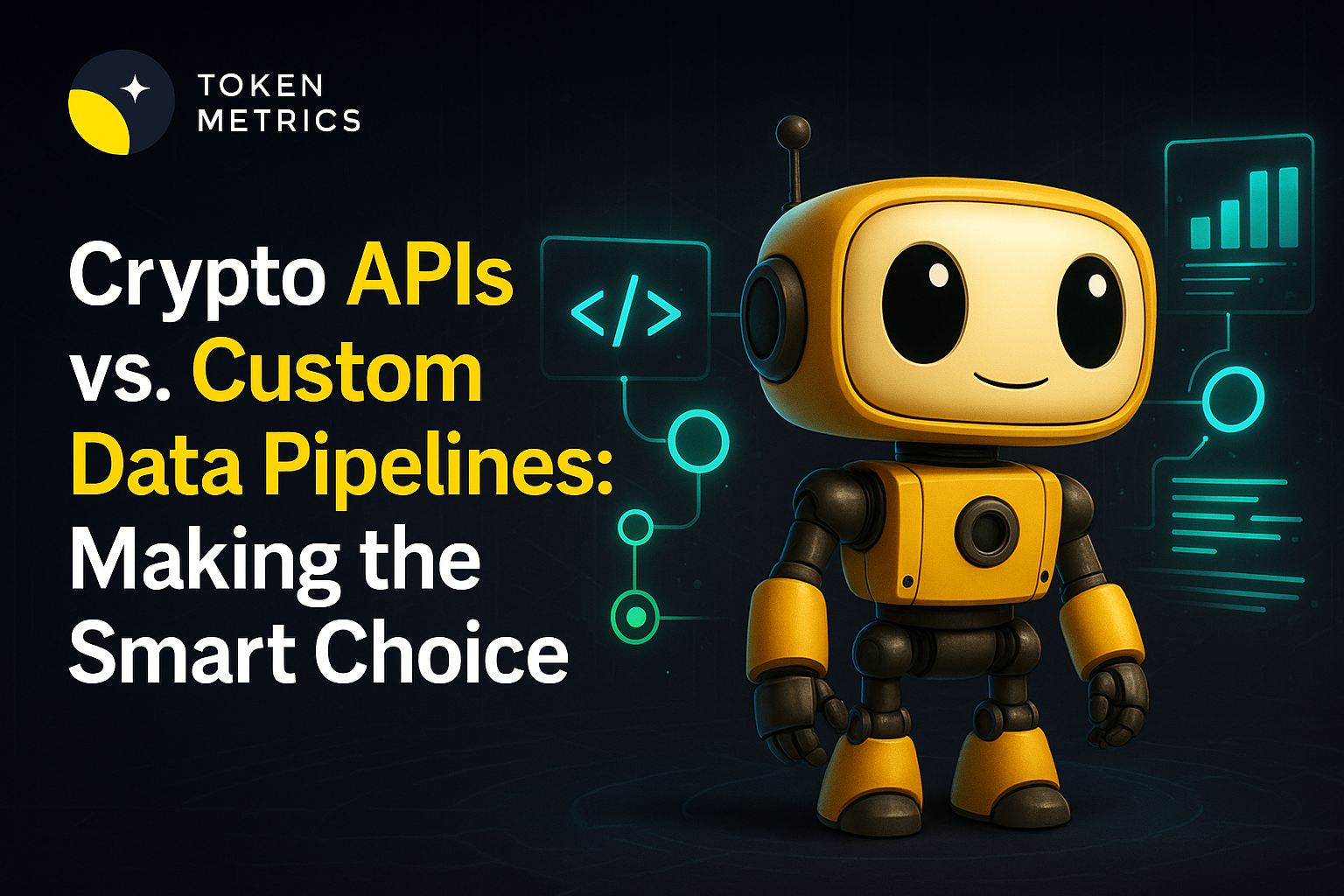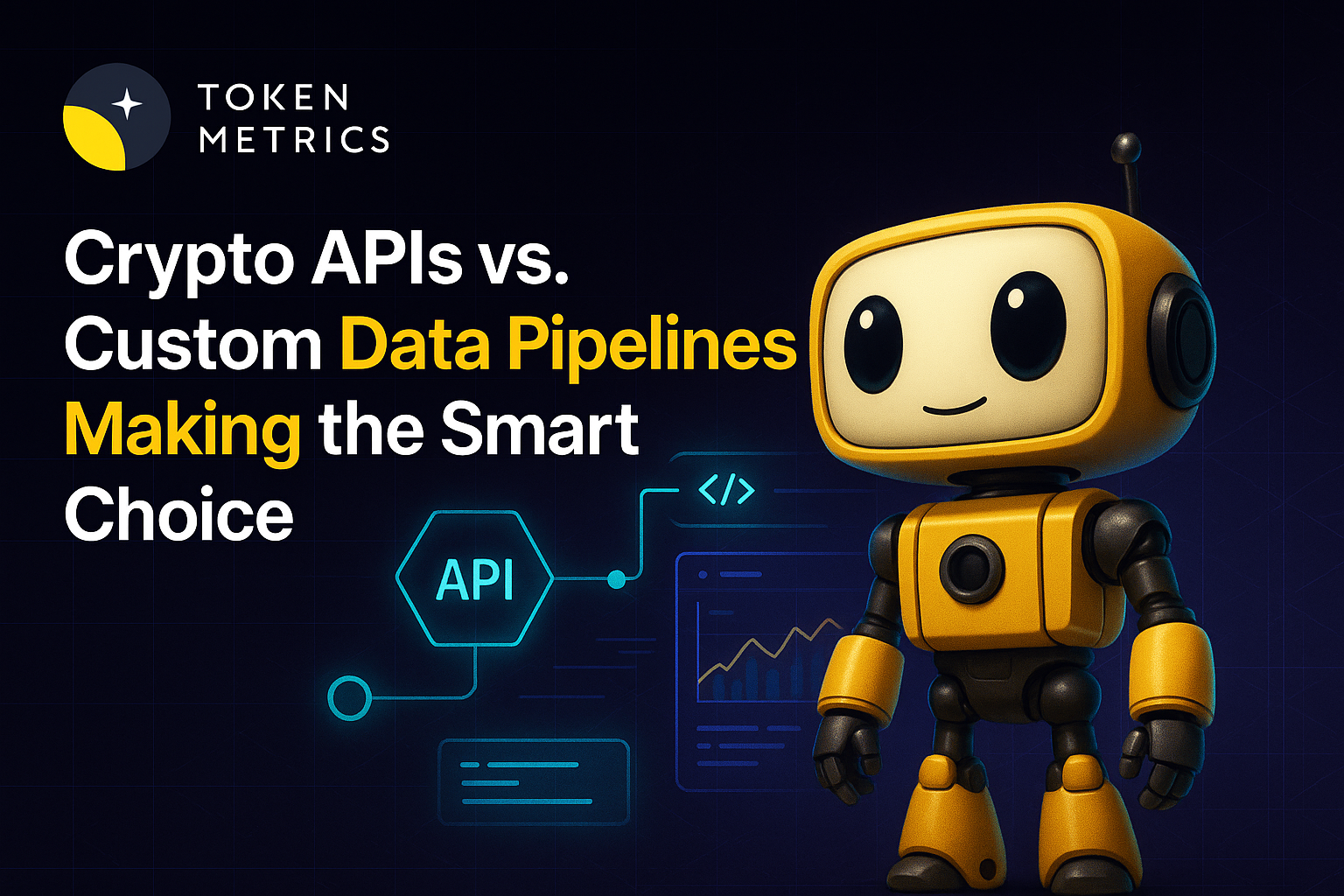AI Crypto Trading: Token Metrics Bullish & Bearish Signals Explained 2025

In the world of cryptocurrency trading, timing isn’t just important — it’s everything.
Buying too early ties up valuable capital. Buying too late means you miss the explosive moves that define crypto trading cycles. That’s why serious traders in 2025 are moving beyond basic technical analysis and adopting advanced AI crypto trading tools that deliver real-time precision.
At the forefront of this evolution is Token Metrics, a leading AI-powered crypto trading platform. Its Bullish and Bearish Signals, driven by cutting-edge AI cryptocurrency trading algorithms, are providing traders with an unprecedented edge — outperforming legacy indicators like RSI, MACD, trendlines, and other traditional tools.
In this detailed guide, we’ll explore exactly how these signals work, why they’re so effective, and how they’re helping traders dominate the crypto trading markets with confidence and clarity.
What Are Token Metrics Bullish and Bearish Signals?
Token Metrics has developed a proprietary system that generates Bullish and Bearish signals across thousands of crypto assets. Unlike simplistic price-based indicators, these signals are built on a sophisticated multi-factor model that combines:
- Price momentum shifts
- Trading volume spikes
- Support and resistance levels
- On-chain activity strength
- Whale wallet flows
- Sentiment analysis
- Historical pattern recognition
- Liquidity and order book depth
Each signal is generated when multiple independent factors align — a process known as signal confluence. This drastically reduces false positives and ensures that only high-probability setups trigger alerts.
In simple terms: Token Metrics Bullish and Bearish Signals don’t trigger based on one factor — they fire when multiple critical data points confirm the setup. This makes them far more reliable than most tools used in traditional cryptocurrency trading.
The AI Advantage: Why These Signals Are Different
What sets Token Metrics apart from standard crypto trading indicators is its heavy use of artificial intelligence (AI) and machine learning models that analyze real market behavior.
Traditional Tools Are Lagging
Popular indicators like RSI (Relative Strength Index) and MACD (Moving Average Convergence Divergence) have been staples of cryptocurrency trading for years. But they share one fatal flaw: they are lagging indicators. They only react after price movements have already occurred.
This delay often causes traders to enter late, miss opportunities, or fall into bull traps right before reversals.
Token Metrics Signals Are Forward-Looking
In contrast, Token Metrics AI Signals are trained on outcomes, not just patterns. The AI models analyze:
- How thousands of past price patterns played out
- Which combinations of factors led to real breakouts or breakdowns
- Which setups frequently produced false signals historically
By learning from historical market outcomes, the AI constantly refines its signal generation, adapting to ever-changing cryptocurrency trading conditions. This adaptability makes the system market responsive, something static indicators like RSI or MACD can’t achieve.
AI Validation & Backtesting
Every signal generated by Token Metrics is validated using AI-powered backtesting. This allows the system to continuously test its models against massive historical datasets, ensuring the signals remain accurate across different market regimes — whether it’s bull markets, bear markets, or sideways ranges.
The end result: a real-time AI cryptocurrency trading system that constantly evolves and improves its accuracy.
Real-World Examples: Token Metrics Signals in Action
During a recent webinar, the Token Metrics team showcased multiple real-world examples of how its Bullish and Bearish Signals outperformed traditional indicators.
Example 1: $DEGEN
- A Bullish Signal was triggered on $DEGEN before a major +35% breakout.
- At the time of signal activation, there was no traditional RSI divergence or MACD cross.
- Traders using Token Metrics entered early, while those relying on standard tools were still waiting for confirmation.
Example 2: $ENA
- A Bearish Signal was triggered on $ENA ahead of a -22% price correction.
- Again, standard technical indicators provided no early warning.
- Traders using AI crypto trading signals were able to exit before the sharp drop.
These examples highlight how AI-powered crypto trading systems offer traders an advantage — not by predicting the future perfectly, but by identifying statistically high-probability setups before they become obvious to the rest of the market.
How Traders Use Token Metrics Signals in Cryptocurrency Trading
The flexibility of Token Metrics signals allows traders across multiple strategies to integrate them into their trading workflows.
1. Signal Confirmation with Trader Grades
Many traders first screen for high Trader Grade tokens (another proprietary AI scoring model within Token Metrics) and then use Bullish or Bearish Signals for entry and exit timing confirmation.
2. Real-Time Alerts
Traders set real-time alerts on specific tokens. When a signal fires, they receive instant notifications via the platform, web app, or API — allowing them to act immediately.
3. Backtesting & Historical Performance
Token Metrics provides overlays on price charts that visually display previous signal triggers. Traders can easily backtest how signals performed historically, building trust in the system’s accuracy.
4. Algorithmic Bot Integration
For advanced users and developers, Token Metrics provides full API access. This allows algorithmic traders and fund managers to integrate Bullish and Bearish Signals directly into automated AI crypto trading bots for fully systematic execution.
Bullish vs Bearish: What Do These Signals Actually Mean?
Bullish Signal
- Multiple AI-validated factors align to suggest that price momentum, volume expansion, sentiment, and technical structure are primed for an upside breakout.
- Signals early momentum shifts before retail traders notice.
Bearish Signal
- Signals deterioration in momentum, liquidity weakening, profit-taking behavior, and increased downside risk.
- Often triggers before obvious technical breakdowns occur.
Unlike basic indicators that react late, these signals give you early actionable intelligence — exactly what’s needed in highly volatile cryptocurrency trading markets.
Token Metrics AI Signals vs Traditional TA Indicators
Feature Token Metrics AI Signals RSI / MACD / Traditional TA
AI-trained on historical outcomes ✅ Yes ❌ No
Multi-factor confluence (80+ data points) ✅ Yes ❌ No
Adaptive to changing market conditions ✅ Dynamic ❌ Static
Intraday real-time updates ✅ Yes ❌ Often delayed
API integration for automated trading ✅ Yes ❌ No
In short: Token Metrics AI Signals give you a probabilistic edge that traditional technical analysis simply can’t offer.
Who Benefits Most from AI Cryptocurrency Trading Signals?
AI-powered Bullish and Bearish Signals can be game-changing for a wide variety of cryptocurrency trading participants:
- Day Traders: Time breakouts early and manage risk efficiently.
- Swing Traders: Identify narrative shifts and sector rotations before price expansion.
- Algorithmic Bot Builders: Feed signals directly into AI crypto trading bots for systematic execution.
- Fund Managers: Avoid drawdowns and rebalance portfolios with quant-level precision.
- Long-Term Investors: Exit fading trends early and reallocate into stronger narratives.
Whether you’re an active trader or a long-term crypto investor, having AI-driven signals at your fingertips gives you a competitive advantage over the majority of traders still relying on outdated, lagging tools.
The Future of Cryptocurrency Trading Is AI-Powered
The cryptocurrency markets have evolved dramatically. In 2025, AI crypto trading is no longer a luxury for large institutions — it’s quickly becoming the standard for serious crypto traders.
- Markets are faster.
- Narratives rotate quicker.
- Capital flows shift hourly.
- Manual chart watching is increasingly obsolete.
With Token Metrics Bullish and Bearish Signals:
- You trade data, not emotion.
- You follow probability, not predictions.
- You respond to real-time conditions instead of reacting late.
In a space where being early is everything, AI cryptocurrency trading delivers the edge traders need to stay profitable in both bull and bear markets.
Conclusion
Crypto trading in 2025 demands smarter tools. Token Metrics Bullish and Bearish Signals represent a major breakthrough in AI crypto trading technology, providing traders with real-time, actionable intelligence that beats traditional indicators.
By combining deep AI analysis, multi-factor modeling, and continuous backtesting, Token Metrics offers one of the most advanced cryptocurrency trading systems available today.
If you want to trade with greater precision, avoid costly mistakes, and stay ahead of volatile market shifts, AI crypto trading signals from Token Metrics are your new secret weapon.
Create Your Free Token Metrics Account

.png)




%201.svg)
%201.svg)


%201.svg)










.svg)




.png)